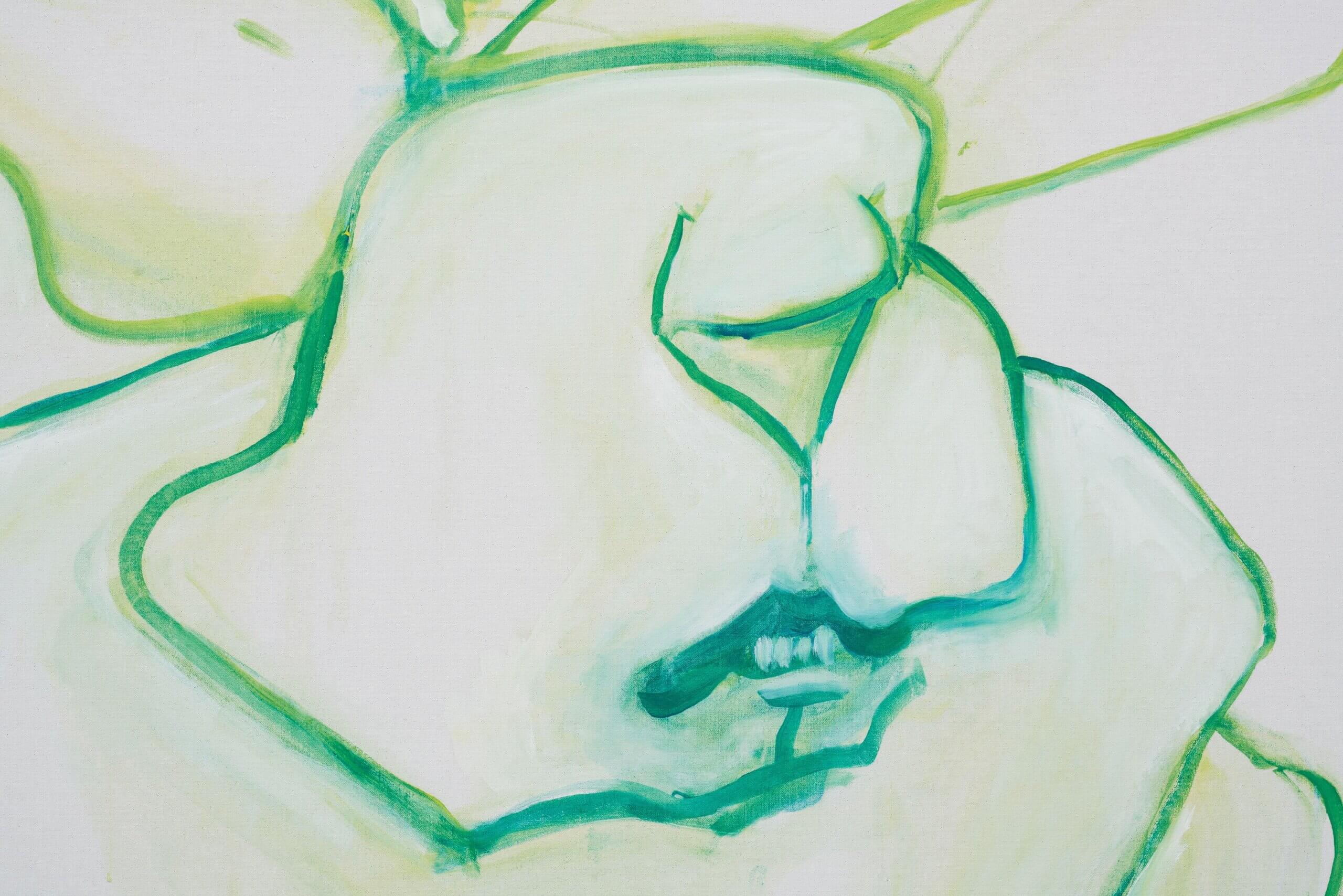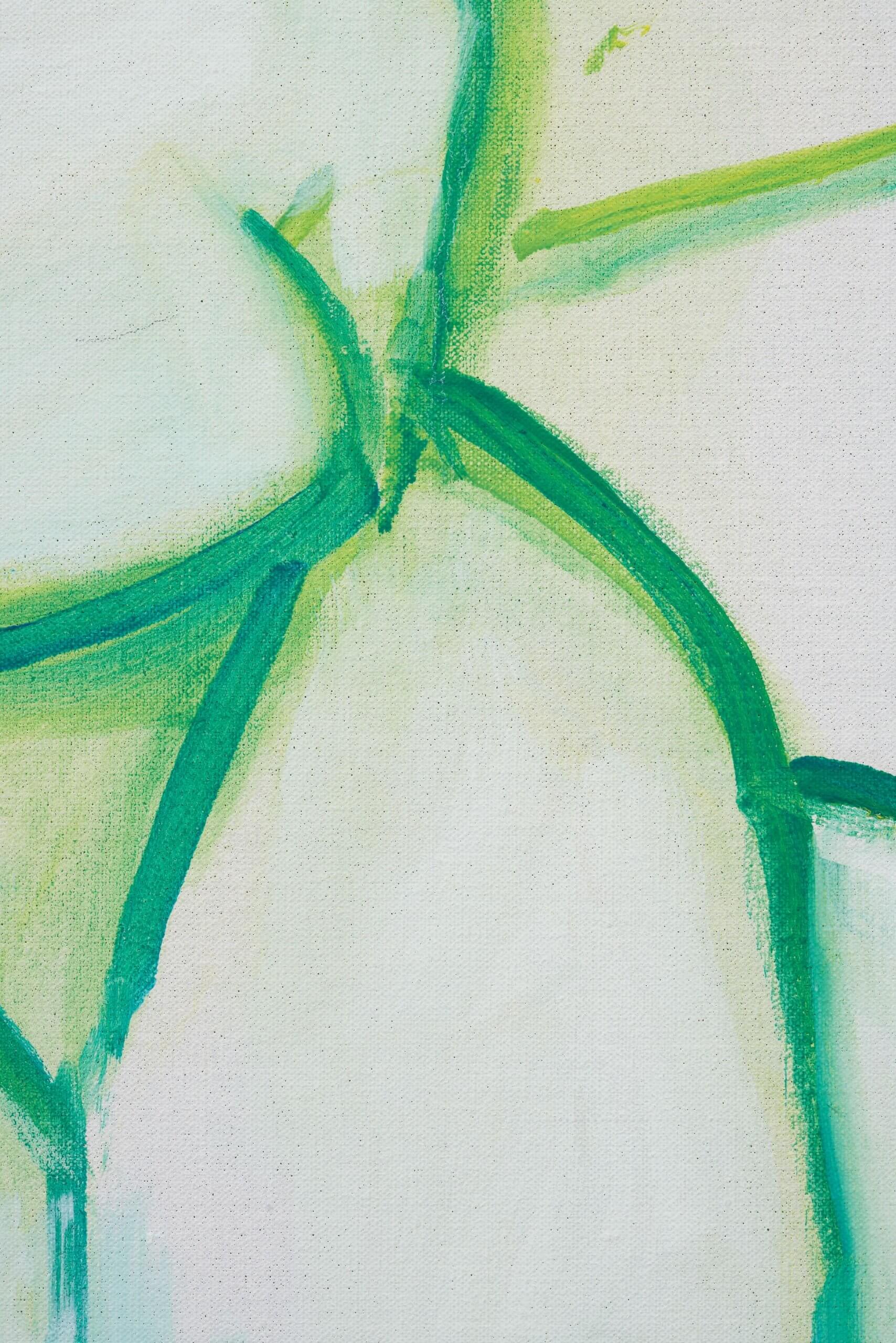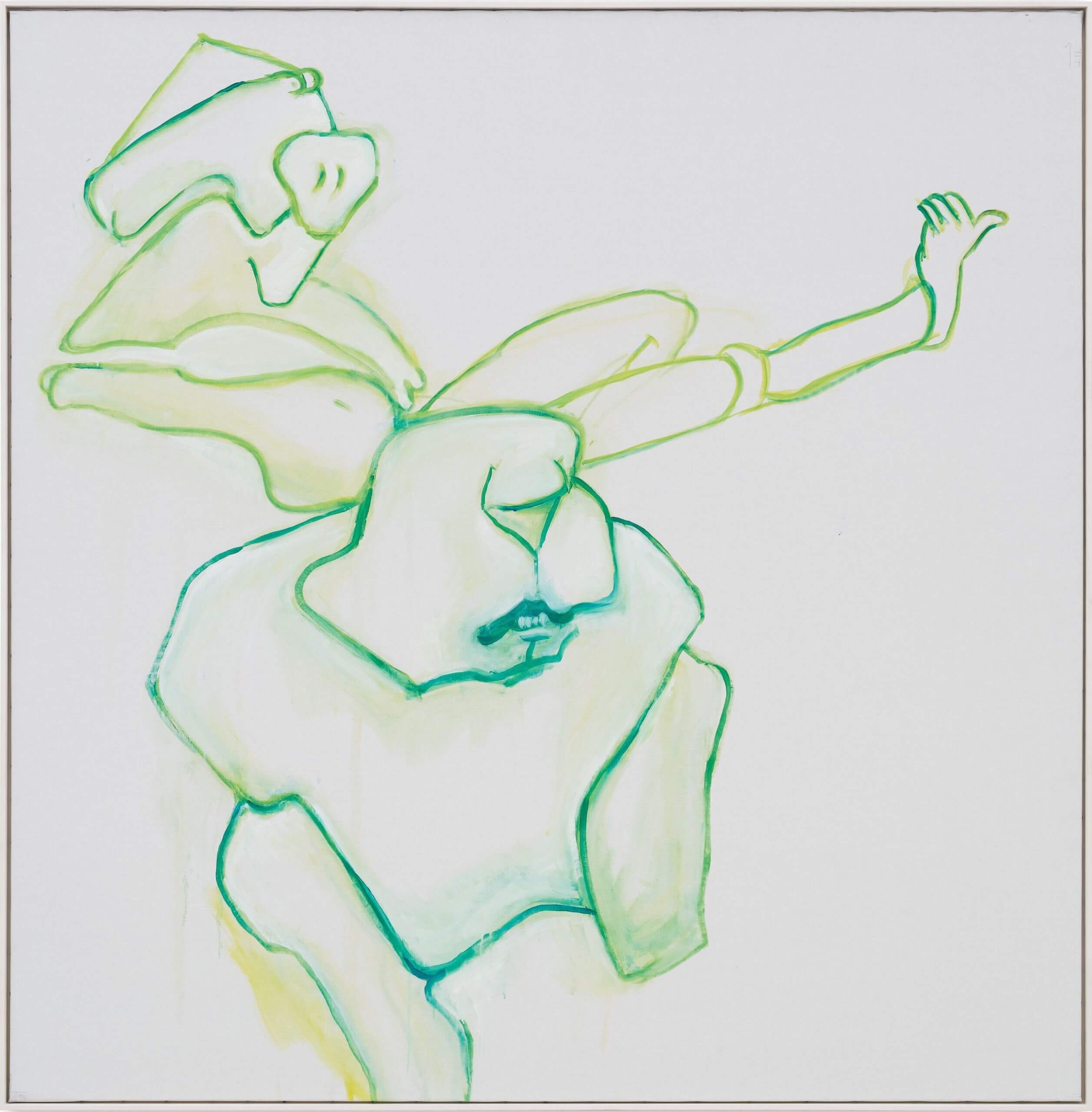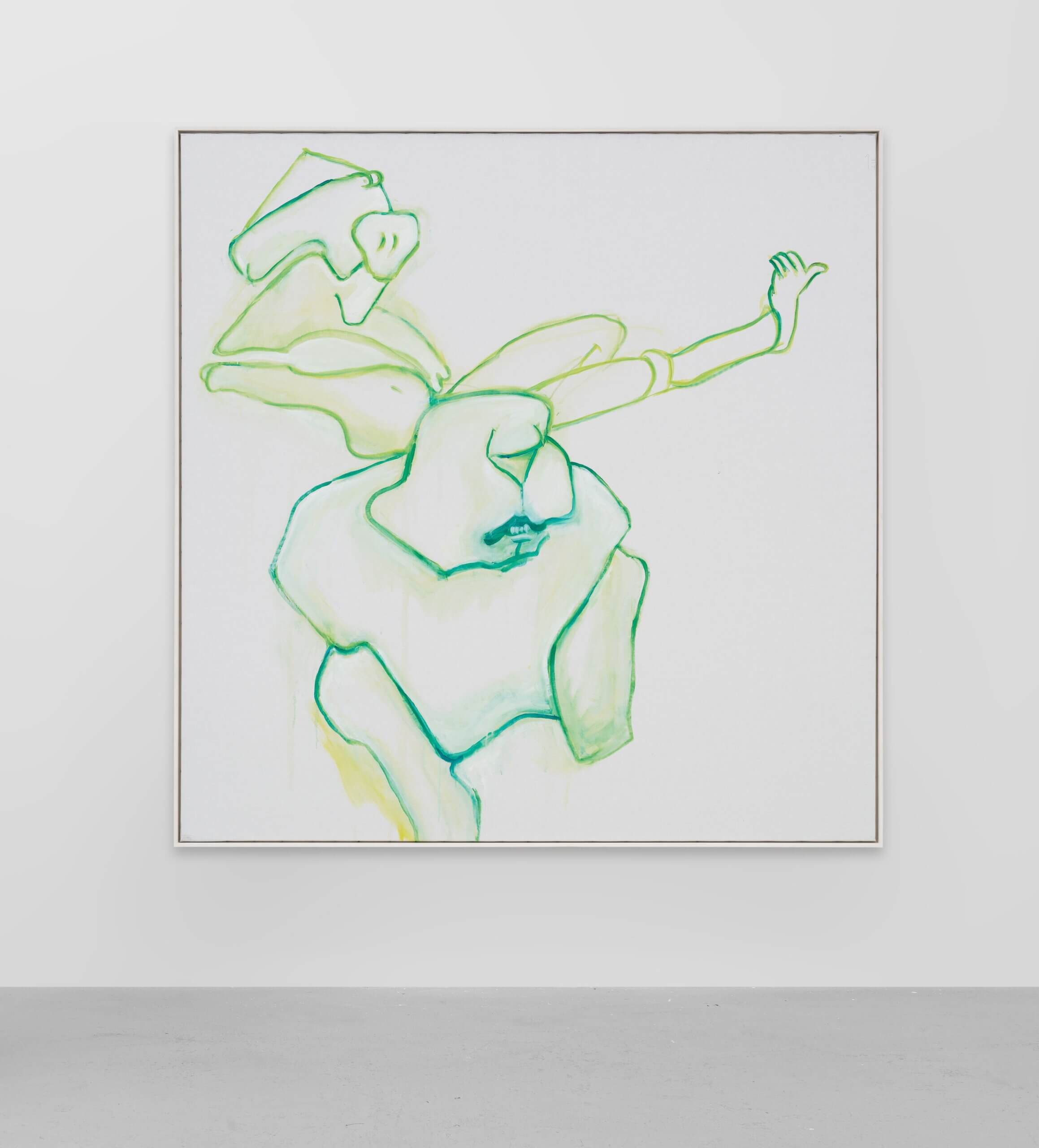
Maria Lassnig
Frau und Mann
(Woman and Man)
Frau und Mann
(Woman and Man)
2007 Oil on canvas 210 x 206.5 cm / 82 5/8 x 81 1/4 in 213 x 210.5 x 4.2 cm / 83 7/8 x 82 7/8 x 1 5/8 in (framed)
‘I don’t know why I painted this sharp blue or this sharp green, but I think that it can express the intensity of a burning sensation across cheeks and neck.’—Maria Lassnig

Maria Lassnig
Born in Carinthia in Southern Austria in 1919, Maria Lassnig’s (1919 – 2014) work is based on the observation of the physical presence of the body and what she termed ‘body awareness’, or ‘Körpergefühl’ in German. She studied at the Academy of Fine Arts in Vienna in the midst of the Second World War. Then, in post-war Europe, she quickly moved away from the state-approved academic realism in which she was trained, looking to Austria’s own avant-garde past, such as the coloration of Oskar Kokoschka and Egon Schiele’s expressionist treatment of figuration.
‘Frau und Mann’ (‘Woman and Man’)
One of the most original and visionary painters of the twentieth century, Maria Lassnig created several of her most extraordinary and evocative paintings during the last decade of her life. While her late work revisits themes and motifs the artist repeatedly explored during a career that spanned more than seven decades, Lassnig continued to invent new ways of translating her internal world on to canvas. Painted in 2007, ‘Frau und Mann’ (‘Woman and Man’) exemplifies Lassnig’s pioneering representation of the body and subjective experience. The striking composition encapsulates the artist’s ‘Körperbewusstseinsbilder’ (‘body-awareness paintings’), a unique form of introspective portraiture focused on capturing and reproducing inner sensations and raw emotions rather than physical appearances. Yet in ‘Frau und Mann’ Lassnig moves beyond her own body to also address gender norms, power dynamics, and relationships; themes the artist engaged with particularly profoundly in her late work. Vibrant and boldly expressive, ‘Frau und Mann’ is a testament to Lassnig’s artistic vision and her remarkable creativity until the very end of her life.
‘Frau und Mann’ draws on several of Lassnig’s most important series, as well as the artist’s earliest forays into figuration. After producing mostly abstract paintings at the start of her career, Lassnig’s practice became increasingly figurative in the early 1960s, when she started producing her remarkable ‘Strichbilder’ (‘Line Pictures’), which she described as ‘body-sensation figurations’. [2] Defined by Lassnig’s confident, confrontational brushstrokes and unique amalgamation of realism and abstraction, the artist’s ‘Line Pictures’ explore the fragmented human figure. [Fig. 1] Lassnig refined these experimentations in her subsequent paintings of anthropomorphic monstrous creatures that externalised her bodily sensations and often resembled animals. [Fig. 2] The large fragmented torso and legs at the centre of ‘Frau und Mann’, as well as the disjointed hand and hare-like nose and teeth, recall these anamorphic early ‘portraits’ that would go on to define Lassnig’s oeuvre. While the artist painted a number of more traditionally representational and allegorical self-portraits with animals both during the 1970s and then again in the early 2000s, the hybrid creature of ‘Frau und Mann’ offers a more enigmatic, disjointed exploration of human emotions and experiences. [Figs. 3 & 4] Shortly before painting ‘Frau und Mann’, Lassnig worked on her ‘Adam and Eve’ series, hoping, as she emphasised repeatedly, to explore both ‘love and hate’. [3] [Fig. 5] Feeling increasingly frustrated with the series, Lassnig turned to ‘Frau und Mann’, creating one of her most candid and brave paintings, which powerfully captures the complexity and turmoil of the ‘big emotions’ the artist wanted to express. [4] Highly ambiguous and deeply personal, ‘Frau und Mann’ epitomises why Lassnig is revered as one of the most influential painters of both the twentieth and twenty-first centuries. Painted when the artist was in her late 80s and finally receiving the recognition she craved and deserved, ‘Frau und Mann’ is a tribute to her skill as a colourist and radically imaginative portraitist. A true pioneer, Lassnig’s unique portraiture poignantly visualises an inner reality few artists have been able to express or capture. As Lassnig herself acknowledged early on: ‘l searched for a reality that was more fully in my possession than the exterior world, and l found it waiting for me in the body house in which l dwell, the realest and clearest reality...’. [5]
[1] Maria Lassnig quoted in Natalie Lettner, ‘Maria Lassnig. Die Biografie’, Vienna/AT: Christian Brandstätter Verlag, 2017, p. 325. ‘Warum ich dieses scharfe Blau malte oder dieses scharfe Grün, weiß ich nicht, ich glaube aber, dass es die Intensität des brennenden Hautgefühls an Wange und Hals ausdrücken kann.’ [2] Maria Lassnig quoted in Adam Budak, Peter Pakesch, Kasia Redzisz (et al.), ‘Maria Lassnig’, Prague/CZ: National Gallery of Prague with Tate, 2018, p. 192. [3] Maria Lassnig quoted in Natalie Lettner, ‘Maria Lassnig. Die Biografie’, Vienna/AT: Christian Brandstätter Verlag, 2017, p. 340. [4] Ibid. [5] Maria Lassnig quoted in Hans Ulrich Obrist (ed.), ‘Maria Lassnig. The Pen is the Sister of the Brush. Diaries 1943-1997’, Goettingen/DE: Steidl Hauser & Wirth, p. 28.


